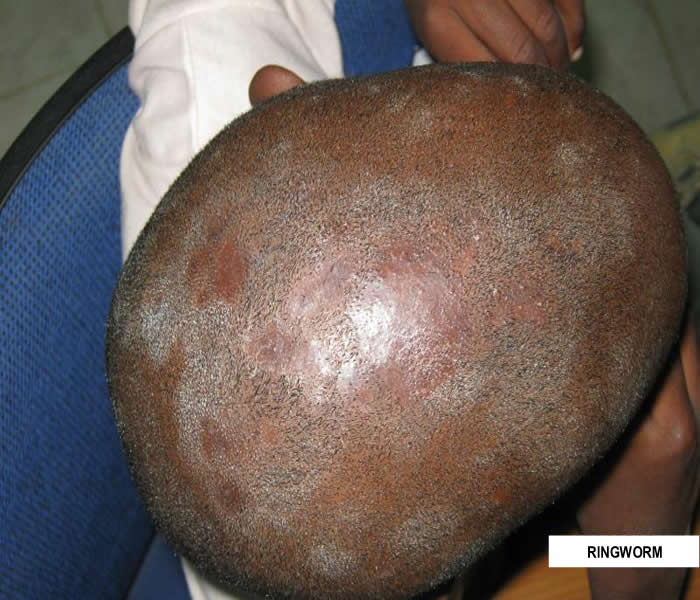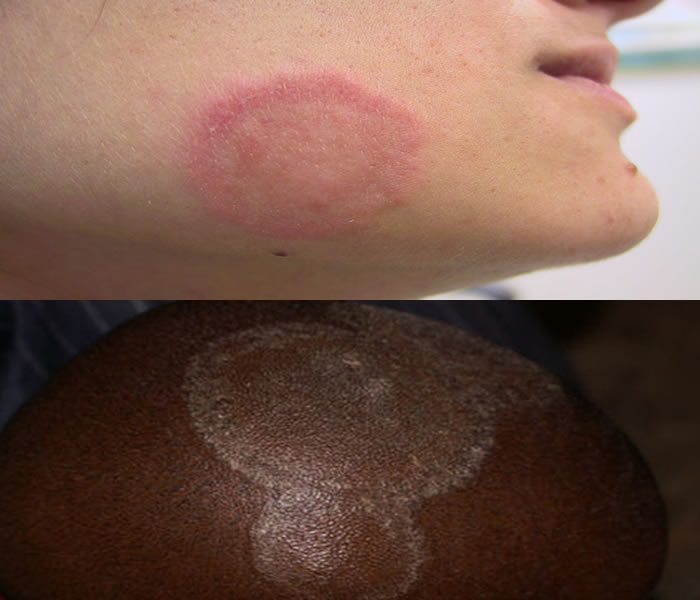Ringworm (Dermatophytosis)

Ringworm (Dermatophytosis)
Dermatophytosis, more commonly known as as ringworm, is a contagious, itching infection of the skin. It occurs in small circular patches. The infection isn’t caused by a worm; it’s caused by a fungus.
How Can you Catch Ringworm?
Anyone can develop ringworm. However, the infection is very common among children and people who own pet cats.
- From person to person by touching a person who has the infection.
- From touching items which have been in contact with an infected person. For example, towels, clothes, bed linen or chairs which have been used by somebody who has ringworm.
- From animals. Some animals such as dogs, cats, guinea pigs and cattle have fungal infections on their skin. They can pass on the infection, especially to children. (Animals can be treated too if you suspect a pet is the cause. See your vet.) Farm animals can also be a source. Touching a farm gate where infected animals pass through may be enough to infect your skin.
- From soil. Rarely, fungi can be present in soil, and you can get the infection from contact with soil.
- You may be more likely to develop dermatophytosis if you come into contact with the fungi while you’re wet or if you have minor skin injuries or abrasions.
- Using a public shower or public pool areas may also expose you to the infective fungi.
- If you’re often barefoot, you may develop ringworm of the feet.
- Those who often share items such as hairbrushes or unwashed clothing also have an increased risk of developing the infection.
Symptoms vary depending on where you’re infected. With a skin infection, you may experience the following:
- Red, itchy, scaly, or raised patches
- Patches that develop blisters or begin to ooze
- Patches that may be redder on the outside edges or resemble a ring
- Patches with edges that are defined and raised
Diagnosing Ringworm (Dermatophytosis)
Your doctor will diagnose ringworm by examining your skin and possibly using a black light to view your skin in the affected area. The fungus will fluoresce (glow) under black light. If you’re infected, the areas of the skin where fungus is located will glow.
Your doctor may confirm a suspected diagnosis of ringworm by requesting certain tests:
If you’re getting a skin biopsy, your doctor will take a sample of your skin or discharge from a blister and will send it to a lab to test it for the presence of fungus.
If you’re getting a KOH exam, your doctor will scrape off a small area of infected skin and place it in potassium hydroxide (KOH). The KOH destroys normal cells and leaves the fungal cells untouched, so they are easy to see under a microscope.
Treatment of Ringworm (Dermatophytosis)
Your doctor may recommend both medications and some lifestyle adjustments to treat ringworm.
Antifungal creams:
You can buy an antifungal cream from pharmacies, or get one on prescription. There are various types and brands - for example, terbinafine, clotrimazole, econazole, ketoconazole and miconazole. These are good at clearing fungal skin infections. There is no evidence that any one cream is better than any other one.
Apply the cream for as long as advised. This varies between the different creams, so read the instructions carefully. Briefly:
- Clotrimazole: apply 2-3 times a day for at least four weeks.
- Miconazole: apply twice a day and continue for 10 days after the skin is back to normal.
- Econazole: apply twice a day until the skin is back to normal.
- Ketoconazole: apply once or twice a day and continue for a few days after the skin is back to normal, cannot be used for children.
- Terbinafine: apply once or twice a day for one to two weeks. Cannot be used for children.
Antifungal tablets:
An antifungal medicine taken by mouth is sometimes prescribed if the infection is widespread or severe. For example, terbinafine, griseofulvin, or itraconazole tablets.
Not all treatments are suitable for everyone. People who may not be able take antifungal tablets include:
- Women who are pregnant or breast-feeding.
- People with certain liver diseases.
- People at risk of heart failure.
- People with long-standing lung disease.
- Elderly people.
- People taking other medication which may interact with antifungal tablets.
- Children.

Home Care
In addition to prescription and over-the-counter medication, your doctor may recommend that you care for your infection at home by practicing some of the following behaviors, including:
- Avoiding clothing that irritates the infected area
- Washing bedding and clothes daily during an infection
- Cleaning and drying your skin regularly
How Long Does Ringworm Last?
Skin medications may clear ringworm in two to four weeks. If you’re experiencing severe dermatophytosis that isn’t responding to over-the-counter treatments or treatment at home, your doctor may prescribe antifungal pills to clear up the infection. Most people respond positively to treatment.
Preventing Ringworm (Dermatophytosis)
You can prevent ringworm by practicing healthy and hygienic behaviors. Many infections come from contact with animals and lack of proper hygiene. Remember to wash your hands after interacting with an animal. If you have a pet, keep its living areas clean and disinfected. If you have a weak immune system, avoid any animal or individuals who are suspected of having dermatophytosis.
In terms of personal care, take your bath regularly, at least twice daily. Wear shoes if you shower in community areas. Avoid sharing personal items such as clothing or comb as these can carry infective spores. Be sure to keep your feet and skin clean and dry.




